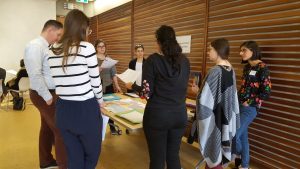 By Charis Lam, Chemistry PhD Student & Innovation Hub Storytelling Team Member
By Charis Lam, Chemistry PhD Student & Innovation Hub Storytelling Team Member
The Future Readiness team shouts, all over each other, in organized chaos. They stand in front of a timeline that’s been scribbled over with quotes, undergraduate milestones, and names of university programs.
It’s a sensory representation of the complexity of UofT narratives they grappled with over the past year, as they sought to answer the question, ‘What would have to be true for a Future Readiness course to be viable at U of T?’
That theme—what would have to be true?—echoes throughout the room, where the five Big Ideas teams have gathered this past Monday to present their results.
What would have to be true for students to use Chill Spots? For them to navigate the maze of university services? For commuters to build community? For faculty, TAs, and students to connect?
Along with faculty and staff members, I rotate through a series of stations, each dedicated to answering one of these questions.
 At the Chill Spots booth, we hear about the prototpe Chill Spot during the Arts & Science Exam Jam: a stress-relieving station full of games and crafts. It sounds fun, innovative, exciting.
At the Chill Spots booth, we hear about the prototpe Chill Spot during the Arts & Science Exam Jam: a stress-relieving station full of games and crafts. It sounds fun, innovative, exciting.
Students didn’t join in.
Come again?
Students don’t want more stimulation and organized activities, the design team explains. They want a place to recharge, zone out, and possibly watch Netflix before they return to their already packed programming.
Such places can easily be created, as shown by the design checklist the team provides.
Of course. It seems obvious now, but the prototype concept during Exam Jam seemed obvious too.
 I hear the same thing as I listen to the Neighbourhood Communities and Future Readiness teams: many ideas sound good, but they aren’t good unless students will use them. And the best test of whether students will use them is just to ask, and really listen, which is exactly the ethos of the Innovation Hub.
I hear the same thing as I listen to the Neighbourhood Communities and Future Readiness teams: many ideas sound good, but they aren’t good unless students will use them. And the best test of whether students will use them is just to ask, and really listen, which is exactly the ethos of the Innovation Hub.
So even though a formal career preparation course sounds like just the thing, and students like the idea, they admit that they don’t actually have the time to take one. Rather, they need the narratives they hear through their pre-existing courses and co-curriculars to change.
And even though commuting students want to connect with each other, they don’t need to be corralled into programming. Instead, the Neighbourhood Communities team suggests that we facilitate initial meetings, give student neighbourhoods a platform to communicate, and get out of the way as they self-organize.
By replacing assumed student desires with actual ones, the Big Ideas teams take a human approach in a system sometimes accused by students of treating them as numbers.
 Take the U of T Concierge team’s recommendations as an example. We could compile a database of all the resources available to students, and we should fix broken links and outdated websites, but most of all, we need to ensure access to a helpful human to assist students in wayfinding. Creating comfort by seeing each other as humans also comes up in the Student-Faculty Exploration Café’s booth. While professors and TAs will always be associated with the stress of lectures and grades, students find them more approachable when they interact with them in a casual environment.
Take the U of T Concierge team’s recommendations as an example. We could compile a database of all the resources available to students, and we should fix broken links and outdated websites, but most of all, we need to ensure access to a helpful human to assist students in wayfinding. Creating comfort by seeing each other as humans also comes up in the Student-Faculty Exploration Café’s booth. While professors and TAs will always be associated with the stress of lectures and grades, students find them more approachable when they interact with them in a casual environment.
Of course, one line or paragraph can never capture a year’s worth of work, and I do justice to neither the complexity of the problems nor the richness of the solutions. I suspect even the teams only skim the surface of their work in the minutes available. Nevertheless, they clarify for us the purpose of the Innovation Hub, a vision which the audience reflects upon as we return from our tour of the stations:
Design does not (always) require programming; (good) design always requires understanding. By designing through conversation with students, the Innovation Hub listens and responds to their actual concerns.
I look forward to seeing these responses grow into solutions, and hope to see UofT take up these ideas with the support of the Innovation Hub.
0 comments on “A Brief Tour of Big Ideas”